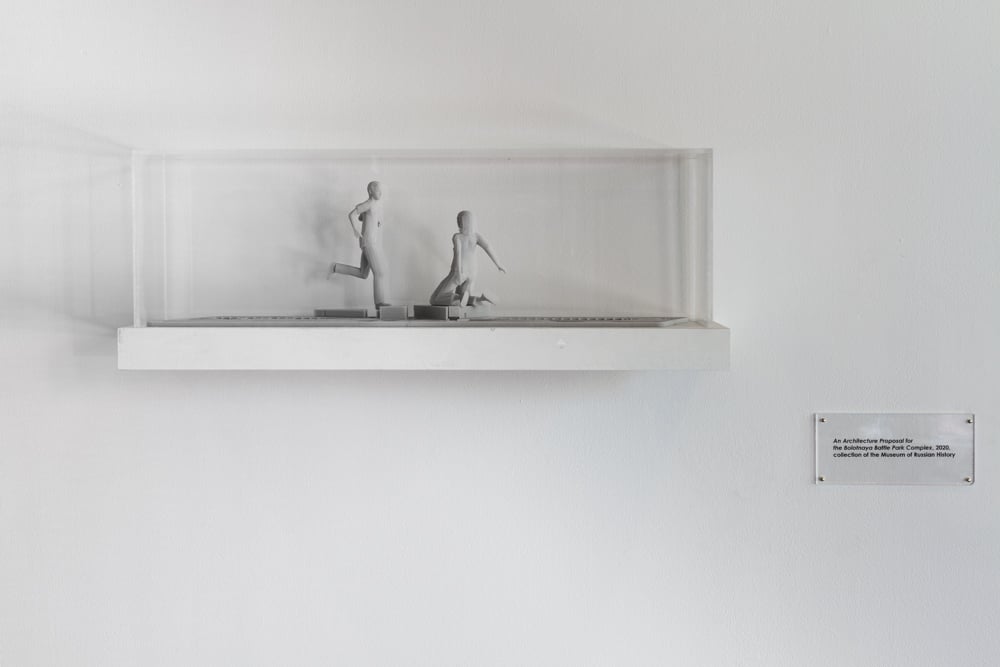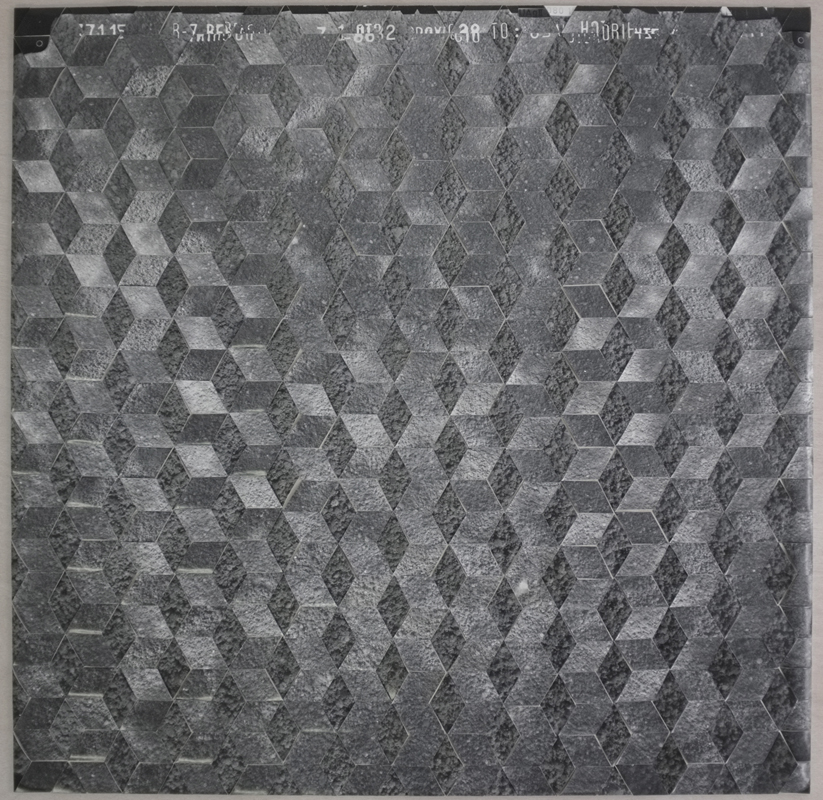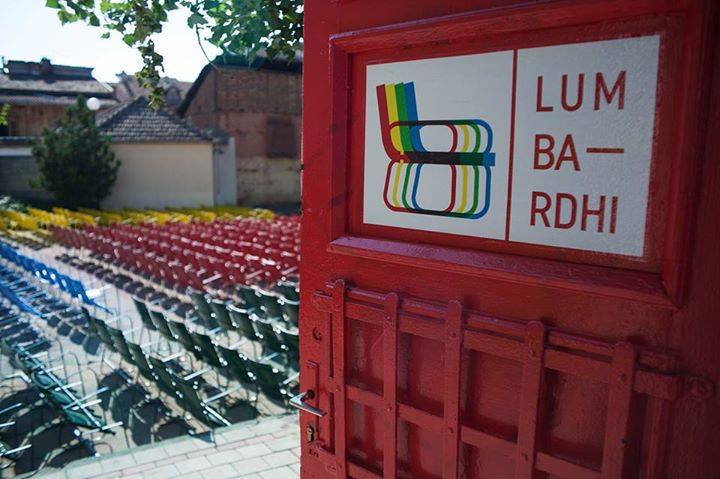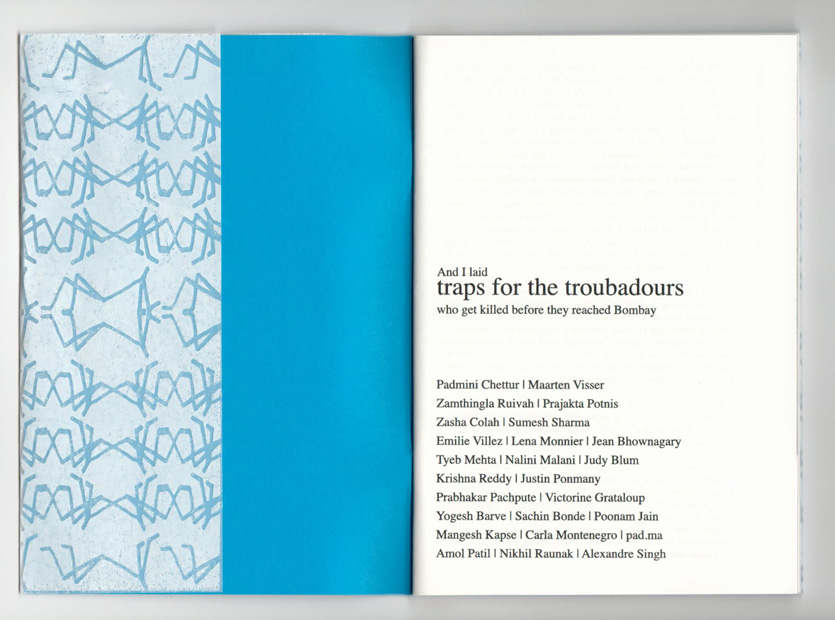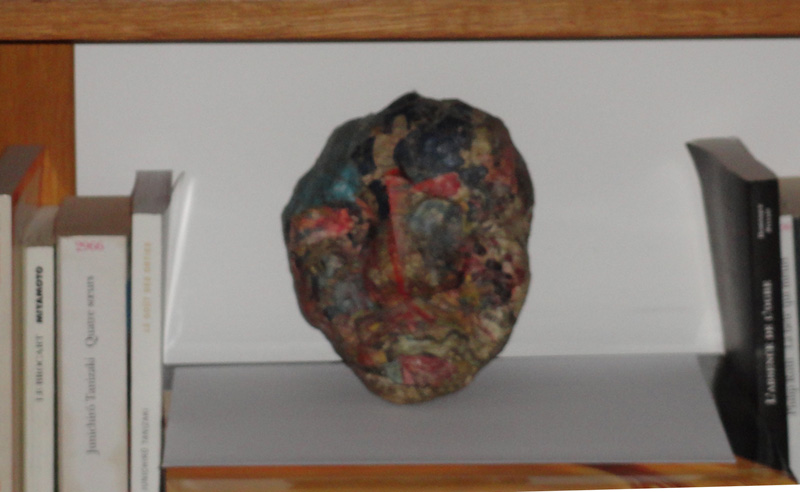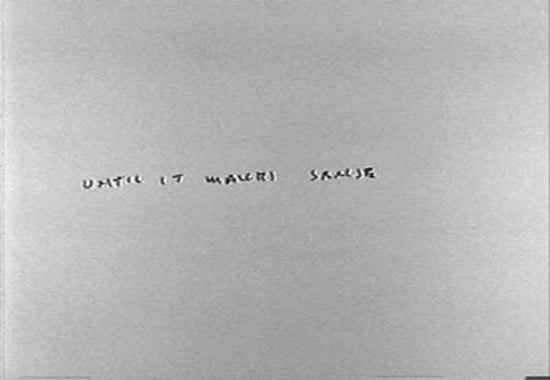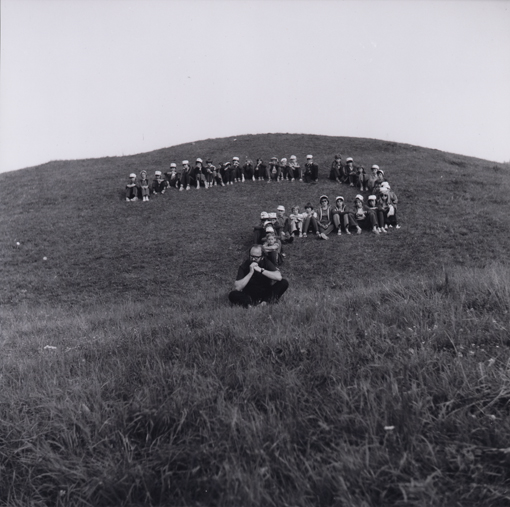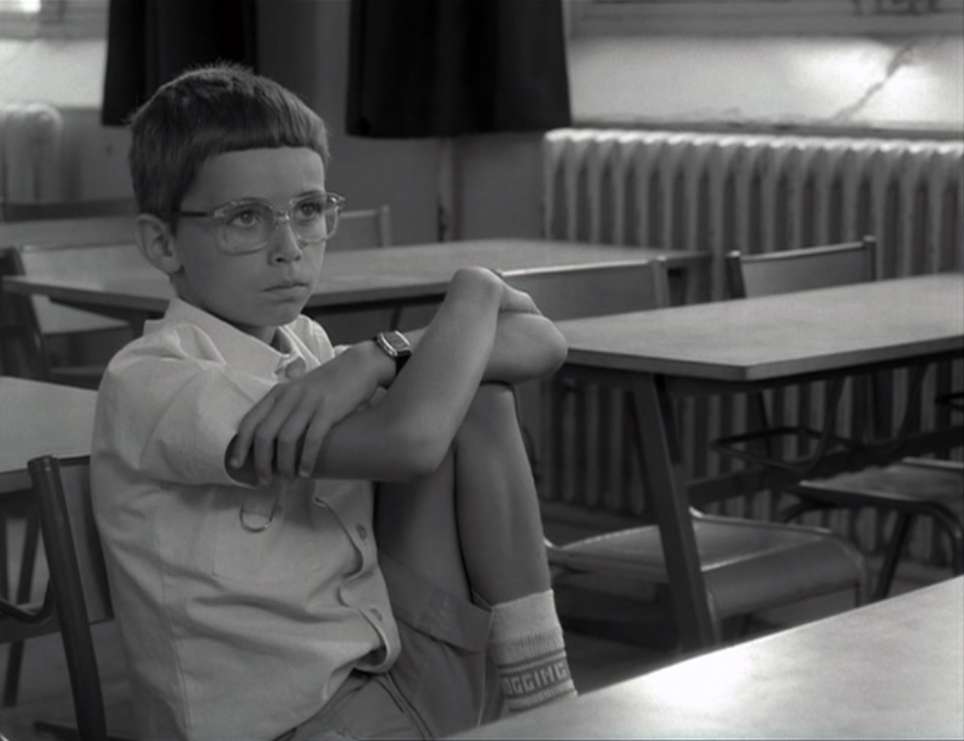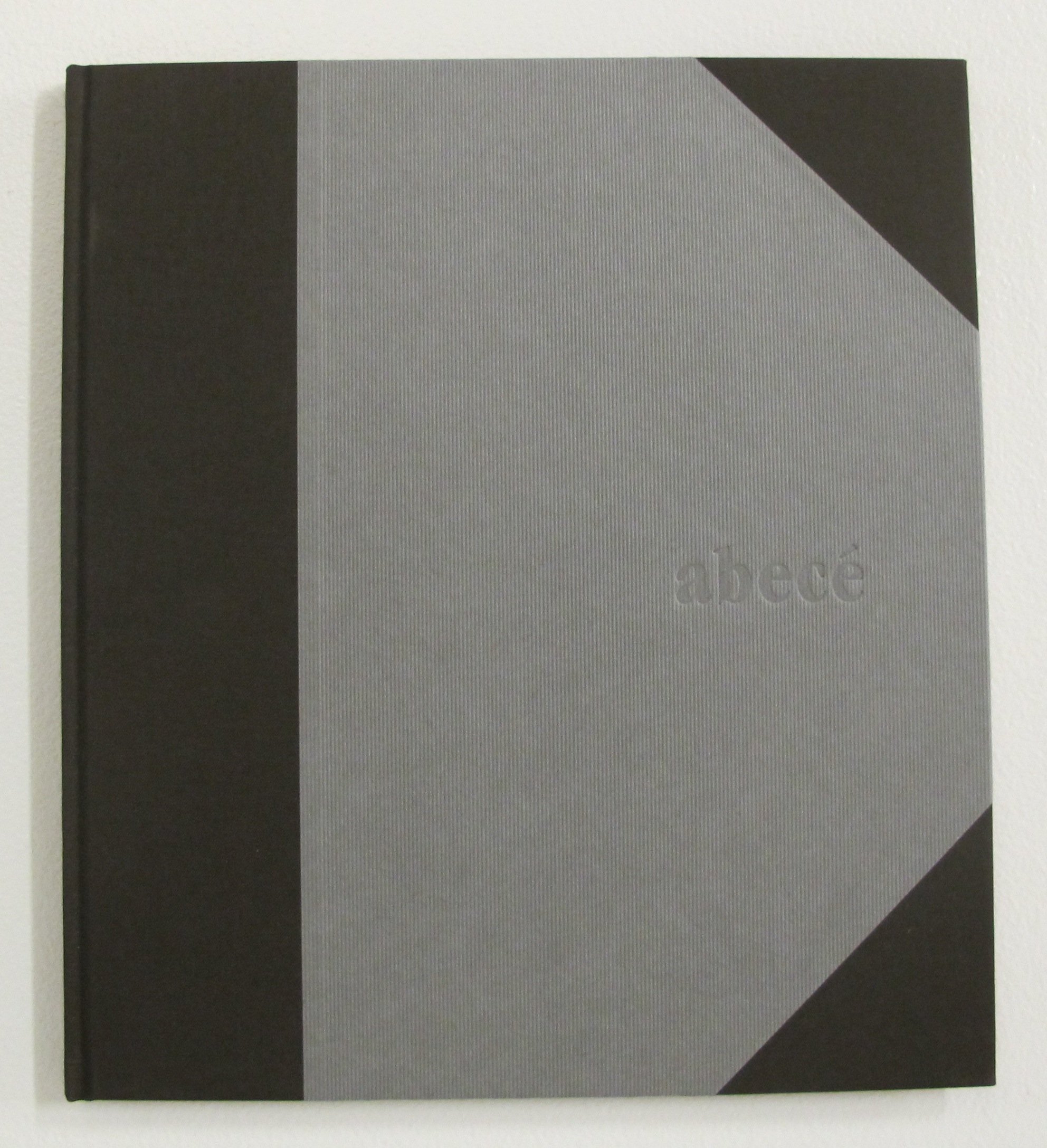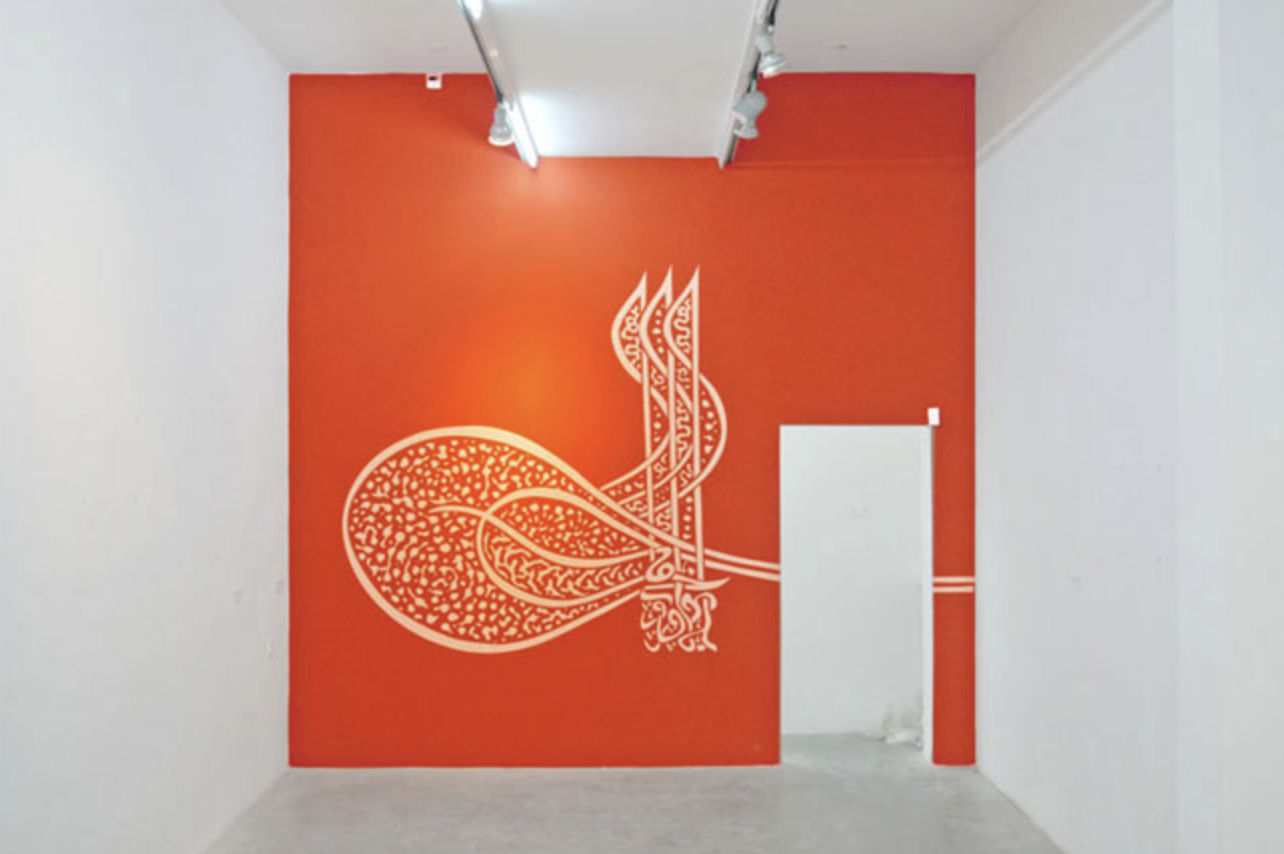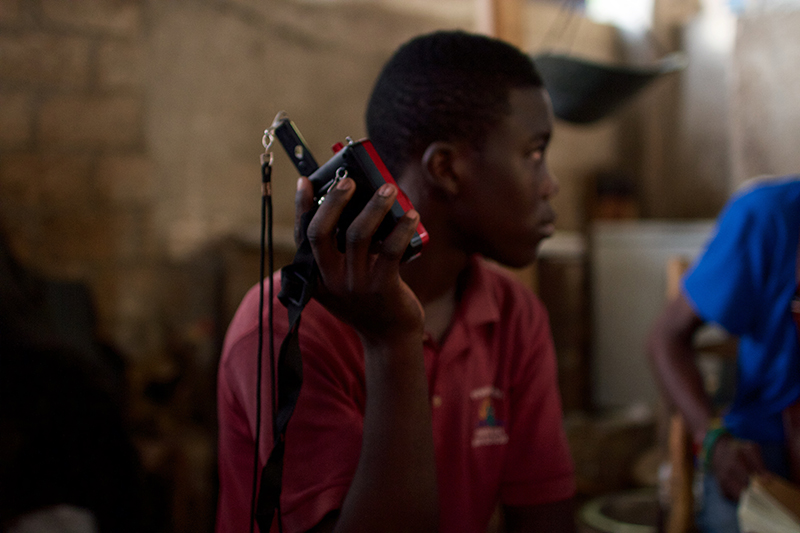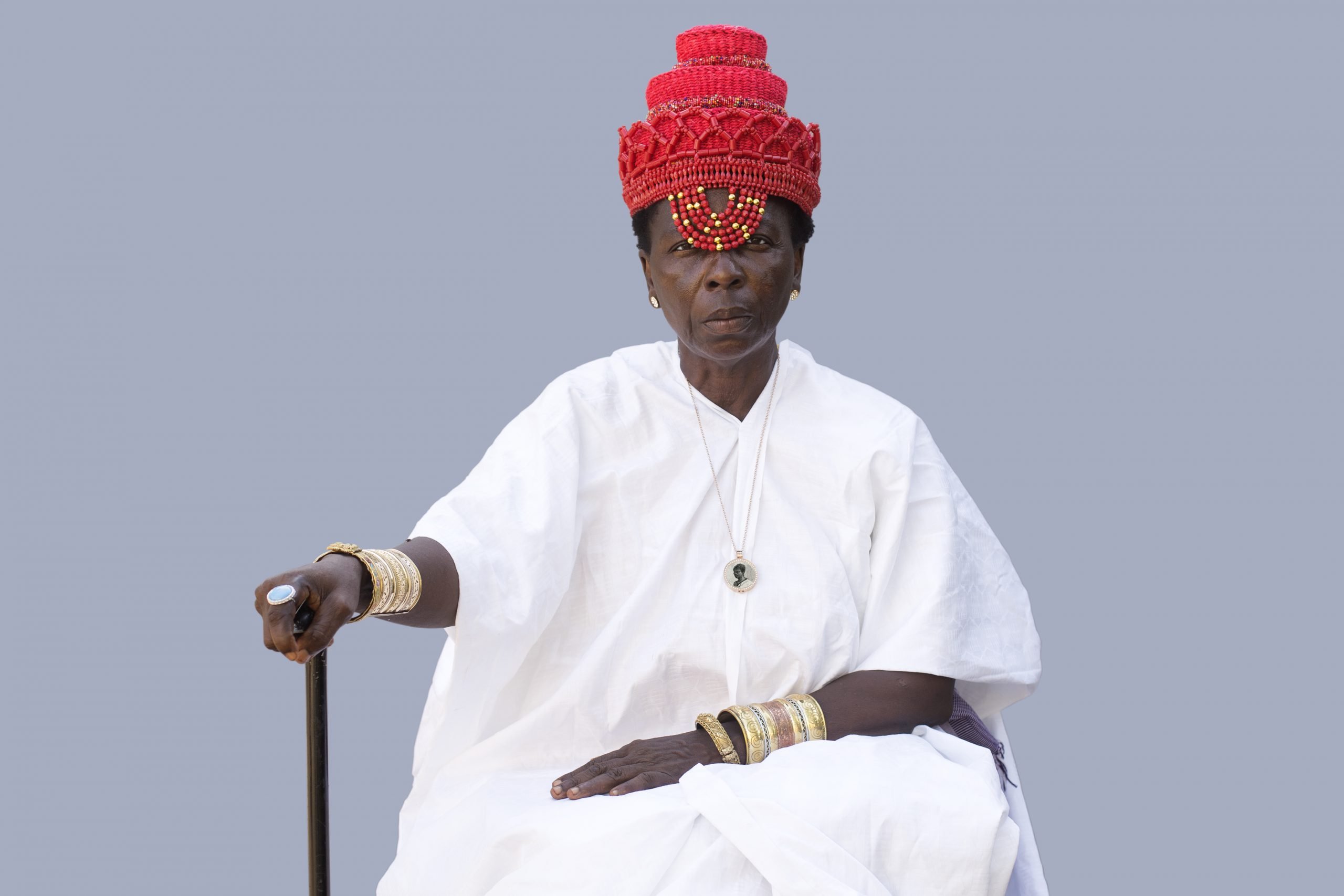
© » KADIST
Gregory Halpern
Gregory Halpern spent five years shooting ZZYZX , and another year editing the results, from an estimated thousand rolls of film, about half of which were shot in the final year after his Guggenheim Fellowship enabled him to live in California. According to Halpern, the series “is grounded in reality, but it occupies an in-between space, between documentary and a certain sense of mystery.” …“I see ZZYZX as part of a continuum but edging a little closer towards fiction.” The series title is borrowed from the village Zzyzx (pronounced zye-zix), formerly Soda Springs, but rechristened by the mineral water pioneer, Curtis Howe Springer, in 1944. The eccentric Springer named it after what he claimed to be the last word in the English language.

© » KADIST
Santiago Borja
Cosmic Tautology I and II are two textile pieces representative of Santiago Borja’s practice and long-standing interest in disrupting universalist assumptions of minimalism by connecting them with other, non-Western or esoteric references. They were hand-woven in Teotitlán del Valle, Oaxaca, Mexico, and are composed of nine squares, the middle one left unwoven. Their composition is based on Red Square, White Letters (1962) by Sol Lewit, but they also take cues from works like Black Series II by Frank Stella.

© » KADIST
Gregory Halpern
Gregory Halpern spent five years shooting ZZYZX , and another year editing the results, from an estimated thousand rolls of film, about half of which were shot in the final year after his Guggenheim Fellowship enabled him to live in California. According to Halpern, the series “is grounded in reality, but it occupies an in-between space, between documentary and a certain sense of mystery.” …“I see ZZYZX as part of a continuum but edging a little closer towards fiction.” The series title is borrowed from the village Zzyzx (pronounced zye-zix), formerly Soda Springs, but rechristened by the mineral water pioneer, Curtis Howe Springer, in 1944. The eccentric Springer named it after what he claimed to be the last word in the English language.

© » KADIST
Gregory Halpern
Gregory Halpern spent five years shooting ZZYZX , and another year editing the results, from an estimated thousand rolls of film, about half of which were shot in the final year after his Guggenheim Fellowship enabled him to live in California. According to Halpern, the series “is grounded in reality, but it occupies an in-between space, between documentary and a certain sense of mystery.” …“I see ZZYZX as part of a continuum but edging a little closer towards fiction.” The series title is borrowed from the village Zzyzx (pronounced zye-zix), formerly Soda Springs, but rechristened by the mineral water pioneer, Curtis Howe Springer, in 1944. The eccentric Springer named it after what he claimed to be the last word in the English language.

© » KADIST
Andrés Pereira Paz
Juan III (Pescadores En Una Isla) is a series of embroideries made with fake pre-Columbian fabrics produced by the Gonzales family, a three-generation family of pre-Columbian textile “forgers” based in Lima, Peru. The members of this family (grandfather, father, and son) all bear the name of Juan and make replicas by hand using traditional methods nearly indistinguishable from the pieces made thousands of years ago. A forgery pretends to be something it is not, but the Gonzalez family’s textiles openly intend to recreate those discovered in the 1920s at a necropolis in Peru.

© » KADIST
Sara Eliassen
Sara Eliassen’s video work A Blank Slate (2014) employs cinematic effect to investigate the relationships between subjectivity, gaze, and memory. Set in a sleepy and unidentified coastal town, the film begins as the protagonist unexpectedly finds herself inside a hotel room in a lucid state. Attempting to grasp her surroundings, she falls into a deeper metaphysical reality where her memories blur with her awareness of her surroundings until she finds herself again alone in a dream-like state.

© » KADIST
Juan Obando
They/Them by Juan Obando is a video essay and deepfake that uses Adobe Stock clips, maintaining their branded watermark, but animating the scenes underneath with a narrative of self-critical awareness. It’s a meta-narrative that uses the staged scenarios (as evidence) to talk about the variable politics (and mercenary capitalism) of the stock footage industry and the misinformation dilemma we’re facing with the arrival of AI technology. In a surprising reversal, a deepfake is used to tell the truth.

© » KADIST
Che Onejoon
Che Onejoon’s unsettling video My Utopia opens with a round table of women asking and answering the questions “Who am I? Where did I come from? Where should I go?” One of the women featured is Monique Macías, the daughter of Francisco Macías Nguema, the first Prime Minister of Equatorial Guinea.

© » KADIST
Gregory Halpern
Gregory Halpern spent five years shooting ZZYZX , and another year editing the results, from an estimated thousand rolls of film, about half of which were shot in the final year after his Guggenheim Fellowship enabled him to live in California. According to Halpern, the series “is grounded in reality, but it occupies an in-between space, between documentary and a certain sense of mystery.” …“I see ZZYZX as part of a continuum but edging a little closer towards fiction.” The series title is borrowed from the village Zzyzx (pronounced zye-zix), formerly Soda Springs, but rechristened by the mineral water pioneer, Curtis Howe Springer, in 1944. The eccentric Springer named it after what he claimed to be the last word in the English language.

© » KADIST
Sinzo Aanza
Projet d’attentat contre l’image? (Acte 3) by Sinzo Aanza brings together literature and objects in their varied forms. This project stems from the artist’s interest in the syncretism that emerged after Congo’s independence in 1960.

© » KADIST
Fehras Publishing Practices
Borrowed Faces is a photo novel published in 2019. These framed colour photographs are selected scenes from the novel. They mimic the aesthetic of a dated comic strip but instead contain vibrantly coloured, digital photos; here the ‘live’ element of the photographic medium meets the theatrics of the graphic novel.
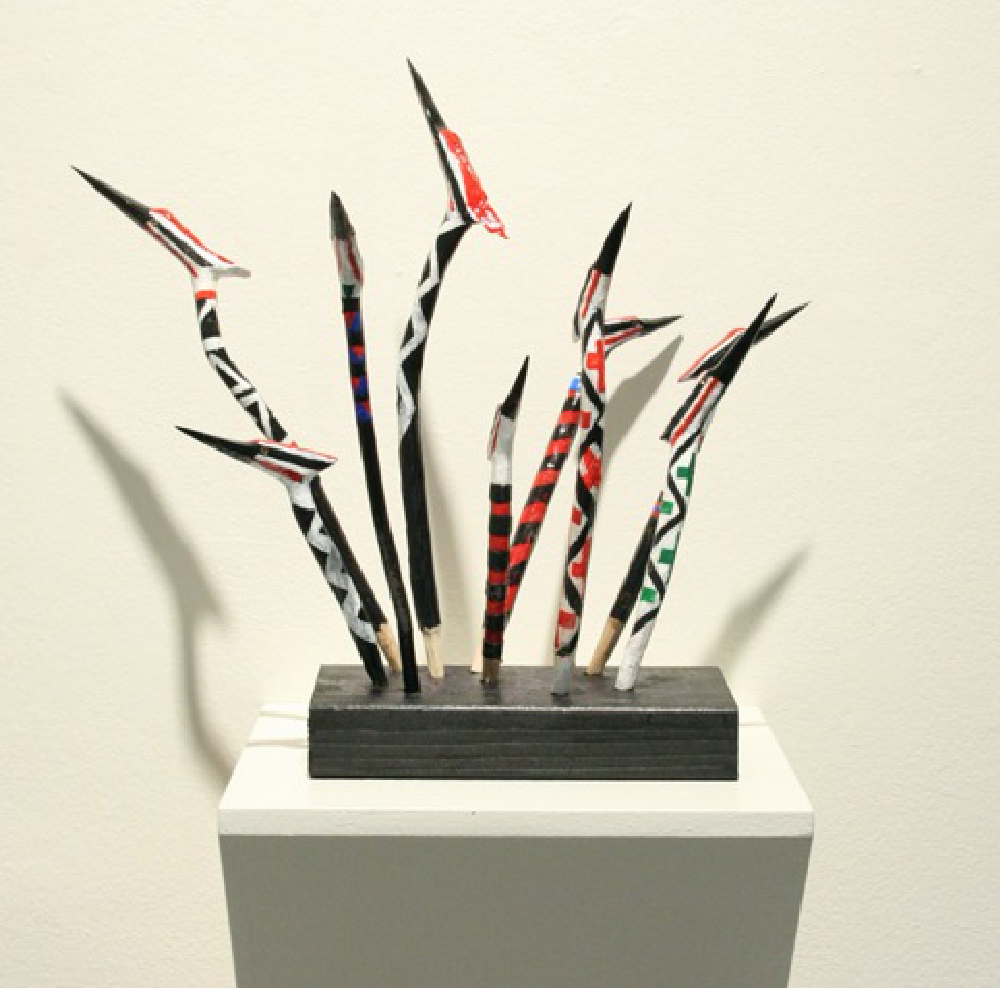
© » KADIST
Brian Tripp
For many years Tripp has been involved in reviving Karuk ceremonies that had been discontinued for decades, he developed his signature abstract style, based in Karuk design, ceremonial regalia forms, and related cultural and political iconography. The two works in the KADIST collection are a continuation of these forms with in the medium of sculpture.

© » KADIST
Dindga McCannon
Dindga McCannon created the radiant portrait Ima: Real Estate Mogul from the Harlem Women’s Series by first stitching material together with a sewing machine and then using more traditional painting techniques to render a portrait of Ima, a woman from Harlem who was a real estate developer from the 20th century. As with other works in the series, McCannon completes the portrait by hand beading a personal and cultural iconography of signs and symbols around the edges of the canvas. The work is spiritual in the sense that it has an energy that comes from its directness and from the human hand.

© » KADIST
rafa esparza
thanks for staying alive Fern.1994 by rafa esparza is from a body of work that pays homage to youth culture in the 90s. The work is based on the popularity of mid-90s era Star Shots photographs, which usually featured graphic backgrounds and highly glamorized subjects wearing heavy makeup, matching outfits, perfectly coiffed hair, and dramatic expressions. In Los Angeles, esparza remembers many Black and Brown youths going to the mall (where many Star Shots photo studios were located) to circulate the photos with personal messages written on the back.

© » KADIST
Patricia Esquivias
Cardón Cardinal by Patricia Esquivias is part of a series of video works in which the artist develops a narrative in front of her computer screen. In this work, the computer sits on a covered piano keyboard, and the reflection of the artist is sometimes visible on the black surface. Cardón Cardinal is a collage of references that revolve around the removal and displacement of a 46 foot tall Pachycereus pringlei , a type of giant cactus also known as a cardón , from Baja California, Mexico to Seville, Spain.

© » KADIST
Wade Guyton
Drawing & Print (Drawing & Print)
This untitled print by Wade Guyton depicts an iteration of elements that are characteristic of the artist’s work. Inkjet printed on canvas is a duplicate flame motif overlaid with a stripe pattern. This work originated in Guyton’s interest in collecting various editions of the novel Firestarter by the popular horror and science fiction author Stephen King.

© » KADIST
Pooja Gurung and Bibhusan Basnet
DADYAA: The Woodpeckers of Rotha by Pooja Gurung and Bibhusan Basnet illuminates a unique and seldom seen international perspective on indigenous cultures and contemporary social issues in the Nepali context. A small masterpiece, the work engages with one of the most pressing social issues in Nepal, mass migration and the dissolving of social fabric in rural areas. The story begins with an old couple, Atimaley and Devi, who live in a village in Jumla, in the highlands of Western Nepal.

© » KADIST
Malick Sidibé
Au bord du Fleuve Niger (1976) offers a unique insight into the lives of the 1970s in Bamako. The photograph provides a glimpse into the notoriously active and exciting life alongside the Niger River, where parties would often last until the early hours of the morning. The gaze of the teenage boys who pose for Sidibé bears witness to an intimate space between the lens of the camera, the artist, subjects and the viewer.

© » KADIST
Ho Rui An
Embracing the conflicting negative and positive affect of the horror genre, Ho Rui An’s film Student Bodies is a self-described work of “pedagogical horror,” that organizes social, political, and economic events in Asia around the motif of the student body. Bound together by a suspenseful, eerie soundtrack, the film temporally cycles through its separate, though thematically interrelated, phenomena and events centering Asian students. Using the student body motif as a human signifier of varied connotations, the film follows phenomenon ranging from the Ch?sh?

© » KADIST
Ana Roldán
Ana Roldán’s Primeval forms series looks up close at the fecund shapes of plants often found in the artist’s native Mexico. These botanical portraits, like this one of the Pseudobombax ellipticum, or shaving brush tree, bristle against the edges of the image’s frame, fecund and wild, familiar yet foreign. Ana Roldán works in diverse media such as performance, sculpture, installations, video and collage.

© » KADIST
Steffani Jemison
In Escaped Lunatic , a steady stream of figures run across the screen, sprinting, jumping, and rolling through the streets of Houston. The work is part of a trilogy that borrows its narrative structure from early-20th-century cinema. The artist employs the chase genre, which has often depicted African Americans in scenes of flight from various forms of authority.

© » KADIST
Karla Dickens
Karla Dickens’s collage Beneath the skim board addresses issues of discrimination and racism towards Indigenous communities in Australia through a constellation of historical and current events. Dickens spent over a year collecting and modifying ubiquitous objects into sculptural collages that commemorate former circus performers of Indigenous Australian descent. Assembled from various fabrics, knick-knacks and other materials, these frenetic compositions celebrate the campy glamour of circus performers, but also articulates the hidden mistreatment experienced by the performers, and more broadly, the lives of Indigenous communities in Australia.

© » KADIST
Colectivo Los Ingrávidos
The word Coyolxauhqui refers to femicide or the killing of women in rural Mexico on the basis of gender. The mutilation of the Aztec moon goddess Coyolxauhqui by her brother Huitzilopochtli, the sun god and human sacrificer, is reimagined in this film. Coyolxauhqui by Colectivo Los Ingrávidos is the first in a trilogy of films that positions itself as a form of political resistance, delving into the relationship between current Mexican femicide and broader cultural traditions.

© » KADIST
Shimon Minamikawa
In Play , the image comes from a fashion magazine from the 1950’s (USA) whose theme is costume sportswear from the 19th century. The image was first used in a series involving playing cards which have subsequently gone on to be used in a series of performances. There is cultural contextual displacement and confusion which is presented in the work which embodies the sense of – Play – that was introduced into Shimon’s work.

© » KADIST
Zai Kuning
Drawing & Print (Drawing & Print)
Converting is a piece about the Orang Laut, often called Sea Nomads, that inhabited the Riau archipelago. They were Christians and pagans that were often oppressed by the majority Muslims in the Riau community and were eventually forced to convert to Islam. Zai conveyed this history in Converting through the stark contrasts of red, white, black.
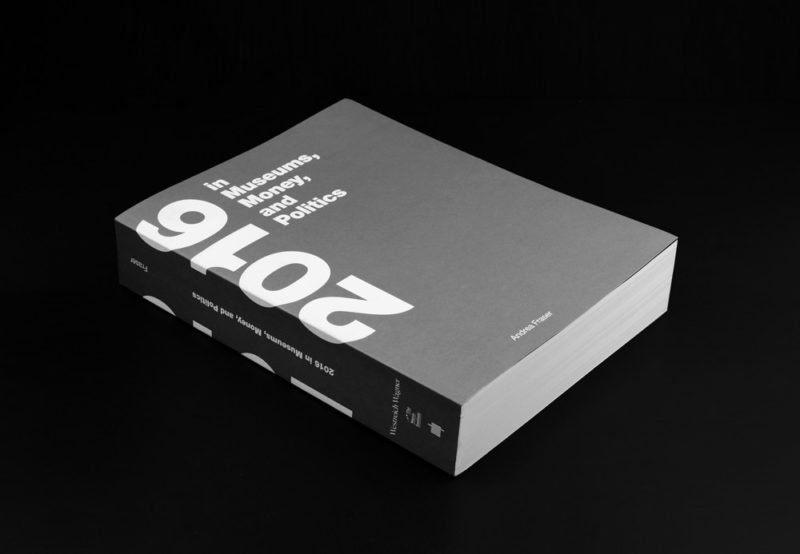
© » KADIST
Andrea Fraser
Drawing & Print (Drawing & Print)
The year 2016 is organized like a telephone book; the data corresponding to the contributions are classified in alphabetical order by the name of the donor. With this database as well as other types of information, the 900-page book presents a material representation of the scale of the cross over between cultural philanthropy and the financing of political campaigns in America. It also provides an unprecedented resource for discovering the political leaning of the museum sector.

© » KADIST
Christian Nyampeta
The film Sometimes It Was Beautiful by Christian Nyampeta poetically addresses the systemic conditions leading and emerging from the 1994 Rwandan genocide, which had lasting and profound effects on Rwanda and neighbouring countries like Congo. The divergent opinions of the characters, as well as suggestive gestures, settings, and marks inscribed in the landscape highlight the different approaches in addressing the slow violence linked to the enduring impact of colonialism and imperialism, the pursuit of knowledge, and the conservation of heritage, culture, and object repatriation. Structured into six chapters, the film imagines a meeting between improbable friends and interlaces dialogues, with choreography of dancers, places and objects.

© » KADIST
Mario Garcia Torres
Mario Garcia Torres films a game of Charades among professional actors guessing the former North Korean dictator’s favorite Hollywood films. Indeed rather surprisingly Kim seems to have had a huge collection of Western videos and he published a book called “On the art of the Cinema” in 1973. As the final acknowledgments indicate, Garcia Torres’s work was produced following in depth research, consulting information given by director Shin Sang-ok who has been kidnapped by Kim in 1978, as well as Jerrold Post (The George Washington University) and Timothy Savage (Nautilus Institute for Security and Sustainable Development).

© » KADIST
Kota Ezawa
The Crime of Art is an animation by Kota Ezawa that appropriates scenes from various popular Hollywood films featuring the theft of artworks: a Monet painting in The Thomas Crown Affair (1999), a Rembrandt in Entrapment (1999), a Cellini in How to Steal a Million (1966), and an emerald encrusted dagger in Topkapi (1964). Ezawa uses his signature cartoon-like style to remix and reenact these crime scenes, leaving only the artworks as “real” objects (as they are depicted in the films), rather than illustrating them. Reversing fiction and reality in an unexpected way, this gesture invites the viewer to question the reliability of the visual footage.

© » KADIST
Lynn Hershman Leeson
Using the seminal 1958 film Vertigo as a launchpad, Lynn Hershman Leeson explores the blurred lines between fact and fantasy in VertiGhost , a film commissioned by the Fine Arts Museums in San Francisco. VertiGhost features the re-creation of select scenes from Vertigo (which takes place in San Francisco), documentation of the life of a painting by Amedeo Modigliani in the Legion of Honor’s collection that was enshrouded by questions of authenticity, as well as interviews—including with the original film’s star Kim Novak— about the construction of realities in life and art. By thoughtfully overlaying these conversations and events, Hershman Leeson distills complex conversations around identity and authenticity into concise insights in just over 12 minutes.
Gregory Halpern
Gregory Halpern is an acclaimed American photographer whose practice is predicated on wandering...
Arseny Zhilyaev
Arseny Zhilyaev is arguably one of the most influential contemporary Russian artists of his generation...
Zai Kuning
- year born: 1964
- gender: male
- nationality: Singaporean
- home town: Singapore
Farah Al Qasimi
Working primarily with photography, video and performance, Farah Al Qasimi examines postcolonial structures of power, gender, and taste in the Gulf Arab states...
Kota Ezawa
- location: San Francisco, California
- year born: 1969
- gender: male
- nationality: German
- home town: Cologne, Germany
Nazgol Ansarinia
- location: Tehran, Îran
- year born: 1979
- gender: female
- nationality: Iranian
Claudia Joskowicz
Claudia Joskowicz is a video and installation artist working at the intersection of landscape, history, and memory...
Brian Tripp
Brian D...
Lynn Hershman Leeson
- location: San Francisco, California
- year born: 1941
- gender: female
- nationality: American
- home town: Cleveland, Ohio
Young Min Moon
Young Min Moon is a Korean American artist, curator, critic, and art historian, who migrated to the United States from South Korea as a teenager...
Matthew Angelo Harrison
Detroit’s Matthew Angelo Harrison works at the intersection of sculpture and technology, building his own 3D printers (which rise to the status of sculpture), and using these creations to formulate others...
Sheroanawe Hakihiiwe
Sheroanawe Hakihiiwe is a Yanomami artist who lives and works in Upper Orinoco, at the Venezuelan side of the Amazon rainforest...
Pierre Gonnord
Pierre Gonnord is known for his large scale photographic portraits of people who inhabit the fringes of society...
Yan Xing
- location: Beijing, China
- year born: 1986
- gender: male
- nationality: Chinese
- home town: Chongqing, China
Ashmina Ranjit
Ashmina Ranjit is Nepal’s leading figure in the conceptual and performance fields, as well as an emblematic voice in South Asian feminist art making and activism...
Sinzo Aanza
Sinzo Aanza is a visual artist, poet, and playwright...
Natalia Lassalle-Morillo
Natalia Lassalle-Morillo’s films explore familial, neighborly, and citizen relationships in the context of Puerto Rico’s fraught history with the United States and the resulting imperialist oppression that has altered generations of families’ material and spiritual trajectories...
Risham Syed
Risham Syed has a diverse art practice in which painting and other mediums are used to explore issues of history, sociology, and politics...
Martin Kippenberger
- location: Vienna, Austria
- year born: 1953
- gender: male
- nationality: German
- home town: Dortmund, Germany
rafa esparza
rafa esparza is a multidisciplinary artist whose work reveals his interests in history, personal narratives, kinship, colonization, and the disrupted genealogies it produces...
Cecilia Bengolea
Trained as an art historian and a choreographer, Cecilia Bengolea works with performance, video, and sculpture, using her own and other people’s bodies as animated sculptures...
Tarik Kiswanson
Tarik Kiswanson is a Palestinian-Swedish artist, poet and writer based in Paris...
Maria Taniguchi
Throughout her paintings, sculptures, and videos, Maria Taniguchi unpacks knowledge and experience—connecting material culture, technology, and natural evolution—and investigates space and time, along with social and historical contexts...
Elena Damiani
- location: Copenhagen, Denmark
- location: Lima, Peru
- year born: 1972
- gender: female
- nationality: Peruvian
- home town: Peru
Rometti Costales
Rometti Costales is an artistic collaboration between Julia Rometti and Victor Costales that began in 2007...
siren eun young jung
With a practice deeply engaged with feminism and LGBT rights issues, siren eun young jung reveals the subversive power of traditional culture, one unknown in the Korean modernization period, and provides unique perspectives and documentation of important communities...
Li Jinghu
Li Jinghu was born in 1972 in Dongguan, Guangdong, where he currently lives and works...
Aubrey Williams
Aubrey Williams was one of the founding members of the Caribbean Artists Movement, formed in the 1960s in the United Kingdom, after settling there in the early 1950s...
Shimon Minamikawa
Since the beginning of his career, Minamikawa Shimon has made work that deviates from conventional painting and other formats...
Lungiswa Gqunta
Lungiswa Gqunta’s practice addresses issues concerning South African post-colonial culture and the country’s contemporary political landscape...
-
1970-1979
Aubrey Williams
1972Carib Carnival illustrates Aubrey Willams’s unique artistic language, combining Pre-Columbian iconography with abstraction...
Malick Sidibé
1976Au bord du Fleuve Niger (1976) offers a unique insight into the lives of the 1970s in Bamako...
Julius Koller
1978This work is one of Koller’s many variations which he began to use from 1970 to describe the ‘cultural situations’ he created...
-
1980-1989
Jean-Marie Straub and Danièle Huillet
1982En rachâchant is based on the short story Ah! Ernesto! (1971) by Marguerite Duras in which the child Ernesto does not want to go to school anymore as all that he is taught are things he does not know...
Martin Kippenberger
Drawing & Print
1989(Drawing & Print) 7″ Single ‘Pop In’ by Martin Kippenbergher consisting of a vinyl record and a unique artwork drawn by the artist on the record’s sleeve...
-
1990-1999
Frédéric Nauczyciel
1999This early photographic work by Fre?de?ric Nauczyciel, titled Untitled (Boîte à prière, Istanbul, Novembre 2005) , features a young man in religious attire reading a religious text from inside a glass prayer box...
-
2000-2009
William E. Jones
2000His series, The Golden State, harkens back to his early career and his photographic training...
Kota Ezawa
2002The Simpson Verdict is a three-minute animation by Kota Ezawa that portrays the reading of the verdict during the OJ Simpson trial, known as the “most publicized” criminal trial in history...
Pierre Gonnord
2002Nakayama is part of a larger body of work by Pierre Gonnord focusing on the analysis and description of the lifestyles of urban youth in large Western cities...
Mario Garcia Torres
2005Mario Garcia Torres films a game of Charades among professional actors guessing the former North Korean dictator’s favorite Hollywood films...
Carla Zaccagnini
2005This series of photographs, Sobre la igualdad y las diferencias: casas gemelas (On Equality and Differences: Twin Houses) , taken in Havana in 2005, belongs to a wider group of works that the artist has been developing over many years, generally titled Bifurcaciones y encrucijadas (Forking Paths and Crossroads) ...
Lynn Hershman Leeson
2007Lynn Hershman Leeson’s genre-bending documentary Strange Culture tells the story of how one man’s personal tragedy turns into persecution by a paranoid, conservative, and overzealous government...
Ahmad Fuad Osman
2007Recollections of Long Lost Memories by Ahmad Fuad Osman is a series of 71 black and white sepia-toned archival photographs that chart, with nostalgia, the social encounters between hierarchies of life in the Malay world...
Goddy Leye
2008Strongly influenced by history and memory, Goddy Leye’s paintings are based primarily on stories and mythologies...
Claudia Joskowicz
2009The primary interest in the trilogy is Joskowicz’s use of cinematic space, with long tracking shots that portray resistance to habitual viewing experiences of film and television...
Bili Bidjocka
2009The short two-channel video Pause/Tanmpo takes its cue from a coincidental encounter artist Bili Bidjocka had in Dakar...
-
2010-2019
Brian Tripp
2010For many years Tripp has been involved in reviving Karuk ceremonies that had been discontinued for decades, he developed his signature abstract style, based in Karuk design, ceremonial regalia forms, and related cultural and political iconography...
Takeshi Murata
2010If one had been guessing at Takeshi Murata’s criticism of American consumerist culture up until watching Infinite Doors , it would be solidified after hearing the announcer from The Price is Right squawk prizes one after the next...
Brian Tripp
2010For many years Tripp has been involved in reviving Karuk ceremonies that had been discontinued for decades, he developed his signature abstract style, based in Karuk design, ceremonial regalia forms, and related cultural and political iconography...
Johanna Calle
Drawing & Print
2011(Drawing & Print) Johanna Calle’s Abece “K” (2011) is part of a series of drawings (compiled into an artist book called Abece ) based on the alphabet...
Wimo Ambala Bayang
2011Composed of four images, the series Sleeping Elephant in the Axis of Yogyakarta (2011) explores the artist’s observation of how Javanese mythology and cosmology have marked the geography of Yogyakarta, the cultural centre of Indonesia...
Santiago Borja
2012Cosmic Tautology I and II are two textile pieces representative of Santiago Borja’s practice and long-standing interest in disrupting universalist assumptions of minimalism by connecting them with other, non-Western or esoteric references...
Ana Roldán
2012Ana Roldán’s Primeval forms series looks up close at the fecund shapes of plants often found in the artist’s native Mexico...
Haris Epaminonda
2012Haris Epaminonda’s work questions the manipulation and the flow of images as well as their power of fascination...
Katia Kameli
2012Katia Kameli’s film The Storyteller explores the cultural role of deep-rooted artistic tradition in Morocco...
Ryan Gander
2012Epiphany…learnt through hardship is composed of a bronze sculpture depicting the model of the little dancer of Degas, in the pose of a female nude photographed by Edward Weston (Nude, 1936) accompanied by a blue cube...
Maria Taniguchi
2012Untitled (Celestial Motors) is a visual meditation on an icon of modern urban Philippine life—the jeepney...
Bani Abidi
2012The perceived effortlessness of power, projecting above experiences of labored subordination is examined in Death at a 30 Degree Angle by Bani Abidi, which funnels this projection of image through the studio of Ram Sutar, renowned in India for his monumental statues of political figures, generally from the post-independence generation...
Elena Damiani
2012Intersticio (Interstice) by Elena Damiani traces the topography of a non-specific site, an in-between zone...
Angelica Mesiti
2013Angelica Mesiti’s piece, The Calling (2013-14) is a poignant exploration of ancient human traditions evolving and adapting to the modern world...
Rometti Costales
2013This anarchist flag is made from Huayruro seeds, a native plant of South and Central American tropical areas...
Sharif Waked
2013Tughra is a protocol by Sharif Waked that reproduces the sixteenth century calligraphic monogram for tughra ; also known as the signature of Suleiman the Magnificent...
Nazgol Ansarinia
2013In the early 2000s, as urban redevelopment accelerated and intense construction significantly diminished public space in Tehran, state-funded murals began to represent imaginary landscapes on building facades...
Maya Watanabe
2013Three men with their backs to each other, dressed similarly in dark colors, stare straight at the camera...
Yao Jui-Chung
2013Long Long Live (2013) takes the viewer to the setting of the Oasis Villa on Green Island, once a reform and re-education prison to house political prisoners during Taiwan’s martial law period...
Zai Kuning
Drawing & Print
2014(Drawing & Print) Converting is a piece about the Orang Laut, often called Sea Nomads, that inhabited the Riau archipelago...
Sara Eliassen
2014Sara Eliassen’s video work A Blank Slate (2014) employs cinematic effect to investigate the relationships between subjectivity, gaze, and memory...
Shimon Minamikawa
2014In Play , the image comes from a fashion magazine from the 1950’s (USA) whose theme is costume sportswear from the 19th century...
Zai Kuning
2014Justice (2014) presents viewers with a curious assemblage: a wooden gallows with slightly curved spindles protruding from the topmost plank, which in turn is covered with rudimentary netting, the threads slackly dangling like a loose spider’s web or an rib cage that’s been cracked open...
Samson Young
2014In Muted Situations #2: Muted Lion Dance by Samson Young, Chinese lion dancers perform the auspicious procession traditionally presented at special occasions such as weddings or during the Lunar New Year...
Mungo Thomson
2014Starting with Bruce Nauman’s iconic artwork, The True Artist Helps the World by Revealing Mystic Truths (Window or Wall Sign) , Mungo Thomson’s neon sign is one of a series that replaces Nauman’s quixotic mini-manifesto with aphorisms from ‘recovery’ culture, especially those made popular by alcoholics anonymous...
Zai Kuning
Drawing & Print
2014(Drawing & Print) Concerned with the early history of Singapore, Zai Kuning spent many years living with and researching the history of the Riau peoples who were the first inhabitants of Singapore...
Claudia Joskowicz
2015Some Dead Don’t Make a Sound (Hay muertos que no hacen ruido) is a single-channel video by Claudia Joskowicz that features the Mexican legend of the Weeping Woman (La Llorona) as its main protagonist...
Taloi Havini
2015Following her family’s political exile to Australia in 1990, Havini began to document her journey’s home to the north of Buka Island, in the Autonomous Region of Bougainville...
biarritzzz
2015biarritzzz is interested in how the development of the internet, and experimentation in the virtual world happens simultaneously with the experimentation in the material world of the human species; and how these developments reflect the precariousness of life within neoliberalism...
Beatriz Santiago Muñoz
2015Marché Salomon by Beatriz Santiago Muñoz depicts two meat vendors, a young man and woman, chatting in Marché Salomon, a busy Port-au-Prince market...
Matthew Angelo Harrison
2015In Hole #1 a zebra scull stands in as a representation of Africa, while the plexiglass box and the hole made through it represent the inaccessibility of that culture to African-Americans....
Gregory Halpern
2016Gregory Halpern spent five years shooting ZZYZX , and another year editing the results, from an estimated thousand rolls of film, about half of which were shot in the final year after his Guggenheim Fellowship enabled him to live in California...
Gregory Halpern
2016Gregory Halpern spent five years shooting ZZYZX , and another year editing the results, from an estimated thousand rolls of film, about half of which were shot in the final year after his Guggenheim Fellowship enabled him to live in California...
Gregory Halpern
2016Gregory Halpern spent five years shooting ZZYZX , and another year editing the results, from an estimated thousand rolls of film, about half of which were shot in the final year after his Guggenheim Fellowship enabled him to live in California...
Gregory Halpern
2016Gregory Halpern spent five years shooting ZZYZX , and another year editing the results, from an estimated thousand rolls of film, about half of which were shot in the final year after his Guggenheim Fellowship enabled him to live in California...
Wade Guyton
Drawing & Print
2016(Drawing & Print) This untitled print by Wade Guyton depicts an iteration of elements that are characteristic of the artist’s work...
Tatsuki Masaru
2016For the works KAKERA, Bullet Train and KAKERA, Loving God Tatsuki Masaru traveled throughout Japan to visit museums holding kakera (which translates to “fragments”) of Jomon Period potteries –Japan’s pre-history 2,300-15,000 years ago...
Matthew Angelo Harrison
2016In Bodily Study of Unthinking Groups, Harrison combines two disparate materials into one stratified stack: automotive clay (used in detailing cars) forms the earthy base, while fragments of zebra skull become imbedded in this falsified soil...
Gregory Halpern
2016Gregory Halpern spent five years shooting ZZYZX , and another year editing the results, from an estimated thousand rolls of film, about half of which were shot in the final year after his Guggenheim Fellowship enabled him to live in California...
Gyempo Wangchuk
2016The various distinct but connected lineages of Himalayan painting remain thriving languages employed by artists from across the region to express their unique perspective in our shared contemporary world...
Haegue Yang
2016A steel clothing rack adorned with turbine vents, Moroccan vintage jewelry, pinecones and knitting yarn, these heterogeneous elements are used here to create an exotic yet undefined identity within the work...
Martine Syms
2016Her 2016 video installation quotes the sitcom-as-form and also draws from a 1907 comedic short, Laughing Gas...
Gregory Halpern
2016Gregory Halpern spent five years shooting ZZYZX , and another year editing the results, from an estimated thousand rolls of film, about half of which were shot in the final year after his Guggenheim Fellowship enabled him to live in California...
Gregory Halpern
2016Gregory Halpern spent five years shooting ZZYZX , and another year editing the results, from an estimated thousand rolls of film, about half of which were shot in the final year after his Guggenheim Fellowship enabled him to live in California...
Yuri Ancarani
2016The Wedding is a silent film, a probing observation of marriage rituals in Qatar in which we soon notice that there is not a single woman visible...
Gregory Halpern
2016Gregory Halpern spent five years shooting ZZYZX , and another year editing the results, from an estimated thousand rolls of film, about half of which were shot in the final year after his Guggenheim Fellowship enabled him to live in California...
Gregory Halpern
2016Gregory Halpern spent five years shooting ZZYZX , and another year editing the results, from an estimated thousand rolls of film, about half of which were shot in the final year after his Guggenheim Fellowship enabled him to live in California...
Gregory Halpern
2016Gregory Halpern spent five years shooting ZZYZX , and another year editing the results, from an estimated thousand rolls of film, about half of which were shot in the final year after his Guggenheim Fellowship enabled him to live in California...
Kota Ezawa
2017The Crime of Art is an animation by Kota Ezawa that appropriates scenes from various popular Hollywood films featuring the theft of artworks: a Monet painting in The Thomas Crown Affair (1999), a Rembrandt in Entrapment (1999), a Cellini in How to Steal a Million (1966), and an emerald encrusted dagger in Topkapi (1964)...
Lynn Hershman Leeson
2017Using the seminal 1958 film Vertigo as a launchpad, Lynn Hershman Leeson explores the blurred lines between fact and fantasy in VertiGhost , a film commissioned by the Fine Arts Museums in San Francisco...
Colectivo Los Ingrávidos
2017The word Coyolxauhqui refers to femicide or the killing of women in rural Mexico on the basis of gender...
Sinzo Aanza
2017Projet d’attentat contre l’image? (Acte 3) by Sinzo Aanza brings together literature and objects in their varied forms...
Chloé Quenum
2017The stained glass windows of Chloé Quenum’s Les Allégories evoke the sacred and describe the movement of a rooster in the form of patterns extracted from a wax fabric found in Benin...
Farah Al Qasimi
2017Farah Al Qasimi’s approach to photography deviates from the norms and conventions of traditional figurative and portrait photography...
Clarissa Tossin
2017Clarissa Tossin’s film Ch’u Mayaa responds to Frank Lloyd Wright’s Hollyhock House (constructed 1919–21) in Los Angeles, an example of Mayan Revival architecture...
Jorge González
2017Easy to fold and carry, Jorge González’s Banquetas Chéveres (Chéveres Stools) embody the nomadic and flexible nature of the Escuela de Oficios...
Lungiswa Gqunta
2017Feet Under Fire by Lungiswa Gqunta depicts the artist’s lower legs swinging in and out of frame, above a bed of charcoal...
Che Onejoon
2018Che Onejoon’s unsettling video My Utopia opens with a round table of women asking and answering the questions “Who am I? Where did I come from? Where should I go?” One of the women featured is Monique Macías, the daughter of Francisco Macías Nguema, the first Prime Minister of Equatorial Guinea...
Andrés Pereira Paz
2018Juan III (Pescadores En Una Isla) is a series of embroideries made with fake pre-Columbian fabrics produced by the Gonzales family, a three-generation family of pre-Columbian textile “forgers” based in Lima, Peru...
Christian Nyampeta
2018The film Sometimes It Was Beautiful by Christian Nyampeta poetically addresses the systemic conditions leading and emerging from the 1994 Rwandan genocide, which had lasting and profound effects on Rwanda and neighbouring countries like Congo...
Pooja Gurung and Bibhusan Basnet
2018DADYAA: The Woodpeckers of Rotha by Pooja Gurung and Bibhusan Basnet illuminates a unique and seldom seen international perspective on indigenous cultures and contemporary social issues in the Nepali context...
Juan Brenner
2018The photographic series Tonatiuh (The Son of the Sun) by Juan Brenner is an in-depth visual study of current Guatemalan society from the perspective of miscegenation and the incalculable consequences of the Spanish conquest...
siren eun young jung
2018Taking the same name as their most recent solo show at the Kunstverein für die Rheinlande und Westfalen in Düsseldorf, siren eun young jung’s video work Deferral Theatre intertwines various threads from the last decade of the artist’s research into the Yeoseong Gukgeuk theatrical form, in which all of the roles are played by women, as well as performance-based modes of queer resistance in South Korea...
Dale Harding
2018Dale Harding’s installation Body of Objects consists of eleven sculptural works that the artist based on imagery found at sandstone sites across Carnarvon Gorge in Central Queensland...
Marguerite Humeau
2018This work forms part of a project that draws upon research into the use of psychoactive substances present in animal brains during the Paleolithic period...
Lala Rašcic
2018In Greek mythology, Arachne was a talented mortal weaver who challenged Athena, goddess of wisdom and crafts, to a weaving contest; this hubris resulted in her being transformed into a spider...
Natalia Lassalle-Morillo
2018La Ruta by Natalia Lassalle-Morillo follows the Panoramic Route, a now weakened infrastructure that meanders through untouched natural landscapes and off-road destinations on the island of Puerto Rico...
Native Art Department International
2018The neon sign Walk the Walk (Sam Durant) overlays a Walk/Don’t Walk Sign crosswalk sign onto the text “You Are On Indian Land Show Some Respect.” The sign asks viewers to not walk on Indigenous lands without respecting it, and, switching between a walking person icon in white and a raised hand icon in red, redirects their actions...
Calderón & Piñeros (La Decanatura)
2018Calderón & Piñeros (La Decanatura) refer to Sólheimasandur as a work that tackles the issue of “the ruin as a tourist destination.” As they say, “at the end, tourists become an essential part of this unusual, beautiful, and—at the same time—banal landscape.” The video features a plane wreck on Sólheimasandur beach in Iceland, where a navy plane belonging to the United States Army crashed in 1973 due to fuel exhaustion...
Gary-Ross Pastrana
2018Gary-Ross Pastrana’s video installation Rewilding consists of three large-scale projections placed across the exhibition space...
Cecilia Bengolea
2018Lightning Dance by Cecilia Bengolea is a black and white video that considers the relationship between extreme weather and the body...
Tarik Kiswanson
2018In late 2017, Kiswanson stared working with Vadim, an eleven-year-old Romanian-French boy who he met during castings for a performance...
Karla Dickens
2019Karla Dickens’s collage Beneath the skim board addresses issues of discrimination and racism towards Indigenous communities in Australia through a constellation of historical and current events...
Kameelah Janan Rasheed
2019Calvin Warren calls it an ‘ontological equation’/or methods of estimating the odds to rise in the coming centuries by Kameelah Janan Rasheed is part of A Casual Mathematics , a series of interpretive art diagrams, which revisit W...
Ana María Millán
2019Interested in role-play and videogames, Ana María Millán developed workshops with different communities in order to create characters and scenarios for her animations, often in collaboration with a choreographer...
Iván Argote
2019Iván Argote’s As Far As We Could Get comprises a series of video chapters made in the municipality of Palembang, Indonesia and the small town of Neiva, Colombia...
Ayoung Kim
2019In 2019, Ayoung Kim traveled to Mongolia to research its widespread animistic belief system towards land, mother rock, stones, and sacred caves that purify human guilt...
Matt Kane
Advanced Technology
2019(Advanced Technology) Matt Kane initiated the project Right Place & Right Time – Bitcoin Volatility Art in 2019...
Sheroanawe Hakihiiwe
2019Perawesi / Estómago de animal / Stomach of animal by Sheroanawe Hakihiiwe exemplify his most abstract work, where he choses particular elements of a living organism to create his renditions...
He Xiangyu
2019He Xiangyu’s Terminal 3 presents excerpts from the lives of young African acrobats attending the Hebei Wuqiao Acrobatic Arts School in China...
Sheroanawe Hakihiiwe
2019Wateoma husipe / Larvas de oruga / Caterpillar larvae by Sheroanawe Hakihiiwe exemplify his most abstract work, where he choses particular elements of a living organism to create his renditions...
Andrew Thomas Huang
2019Highly autobiographical, exquisitely made and compiling different aspects of the artist’s practice, Kiss of the Rabbit God is one of Andrew Thomas Huang’s most precise, relevant, and successful videos...
Park Chan-Kyong
2019Park Chan-Kyong’s otherworldly film Belated Bosal primarily follows two women as they navigate their way up a spectral mountain and through what appears to be a history museum or nuclear disaster bunker...
-
2020-2029
rafa esparza
2020thanks for staying alive Fern.1994 by rafa esparza is from a body of work that pays homage to youth culture in the 90s...
Andrea Fraser
Drawing & Print
2020(Drawing & Print) The year 2016 is organized like a telephone book; the data corresponding to the contributions are classified in alphabetical order by the name of the donor...
Patricia Esquivias
2020Cardón Cardinal by Patricia Esquivias is part of a series of video works in which the artist develops a narrative in front of her computer screen...
Ashmina Ranjit
2020While most of Ashmina Ranjit’s work has been large-scale installations, often immersive and site-specific, the series Hair Warp – Travel Through Strand of Universe is a brilliant concentration of both her beliefs and aesthetic...
Pu Yingwei
2020ChinaCapital: Dream, Hot Land, Interstellar Colonization by Pu Yingwei addresses a complicated phenomena of intertwined influences from different political powers, capital forces, and ideologies in the reality of China...
Paloma Contreras Lomas
Drawing & Print
2020(Drawing & Print) Paloma Contreras Lomas sometimes incorporates large scale drawing into her practice...
Dindga McCannon
2021Dindga McCannon created the radiant portrait Ima: Real Estate Mogul from the Harlem Women’s Series by first stitching material together with a sewing machine and then using more traditional painting techniques to render a portrait of Ima, a woman from Harlem who was a real estate developer from the 20th century...
Sofía Córdova
2021Set some time in the future, Sofía Córdova’s multi-channel film installation GUILLOTINÆ Wanna Cry, Act Yellow: Break Room imagines a public that worships pop stars and revolutionary leaders equally...
Nathan Lewis
Drawing & Print
2021(Drawing & Print) Nathan Lewis has always made figurative and abstract drawings, which are related to anatomical textures and patterns he encountered when working as an ICU nurse...
Ishola Akpo
2021Noticing the lack of archives on the queens of various African kingdoms, artist Ishola Akpo created several series of work that retrace their history...
Hoda Afshar
2022In the islands of the Strait of Hormuz off the southern coast of Iran, a distinctive local culture has emerged as the result of many centuries of cultural and economic exchange, the traces of which are seen not only in the material culture of these islands but also in the customs and beliefs of their inhabitants...
Walid Raad
2022For his first NFT release artist Walid Raad made a series of animated birthday cakes, titled Festival of Gratitude , for some of the world’s most toxic and larger-than-life leaders...
Lotus Laurie Kang
2022Scaffold by Lotus Laurie Kang features a seemingly disjointed amalgamation of materials between flat fabrics and lumps of aluminum...
Yuyan Wang
2022One Thousand and One Attempts to Be an Ocean by Yuyan Wang reflects on the experience of not being able to see the world with depth perception...
Young Min Moon
2022Young Min Moon’s recent paintings repetitively portray the rituals bound up in the Korean tradition of Jesa ...
Farah Al Qasimi
2022Um Al Dhabaab (Mother of Fog) by Farah Al Qasimi addresses the myth of Al Qasimi tribe-instigated piracy in the Gulf, perpetuated by the British Empire and upheld by contemporary western academia...
Risham Syed
2022Risham Syed discovered a box of woven Chinese silk panels that was her mother’s most prized possession...
Sandra Monterroso
2022Sandra Monterroso’s video performance titled Corazón del lugar del viento (Heart of the Place of the Wind) is inspired by Seis Cielo (Six Sky), the only female Mayan ruler to be represented in classical Mayan stelae (historical monuments dedicated to the record of important events)...
Tessa Mars
2022In this untitled acrylic painting, Tessa Mars explores the long-lasting effects of colonialism on the Afro-Caribbean diaspora, particularly in terms of female vulnerability and resilience...
Young Min Moon
2022Young Min Moon’s recent paintings repetitively portray the rituals bound up in the Korean tradition of Jesa...
Juan Obando
2023They/Them by Juan Obando is a video essay and deepfake that uses Adobe Stock clips, maintaining their branded watermark, but animating the scenes underneath with a narrative of self-critical awareness...
